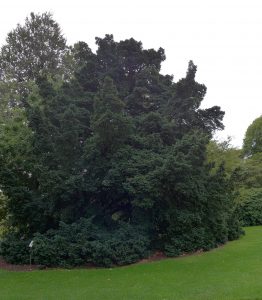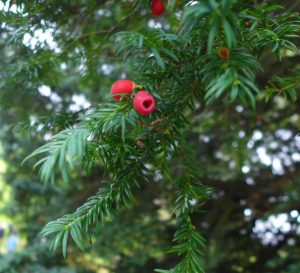Yew – Taxus baccata (Taxaceae)
Gaelic: iubhar
The evergreen conifer Yew is native to Europe and Asia Minor. It can be very long-lived, with reports of trees reaching thousands of years old. It has separate male and female trees (dioecious); the cones of male trees are small and golden, producing huge clouds of pollen in late winter. The female trees bear the distinctive red fruits, a single seed surrounded by a fleshy red aril. All parts of the tree, except the red aril are poisonous.
The wood is purple-red in colour and dense, making it suited for use in turning and furniture making. It has also been traditionally used for the making of long bows. The toxins which make Yew so poisonous are a precursor to a chemotherapy drug, which is derived from the leaves.
Yews are a familiar tree of churchyards, and it has had a long association with death, dating back to pre-Christian times, and it is likely that many Yews in modern churchyards are the remnants of a previous pagan site. It was planted on graves as it was believed that the roots would feed on the dead bodies and release the soul.
Location



2 Comments
2 Pingbacks